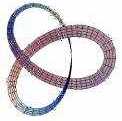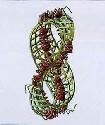 
|
|
 
|
 
|
|
 
|
| Instructor: | Dr. Jan Pearce |  |
C.P.O.: | 1815 |
| Office: | 304-B Draper Hall
(859) 985-3569 |
Office Hours:
|
MTWRF 1:00 to 1:50 pm | |
| Email: | jan_pearce@berea.edu | Feel free to send email for appointments at other times. | ||
The Course Description TOPOLOGY. Topological spaces will be approached by abstracting from a
preliminary study of metric spaces. Topics in metric and/or topological settings
include open and closed sets, open base and subbase, first and second countability,
dense sets, continuity, metrizability, compactness, connectedness and separation properties.
|
The Course Goals
|

Mobius Strip II by M.C. Escher |
The Class Atmosphere The members of this class constitute a learning community. Learning in such a community best takes place in an atmosphere in which instructor and the students treat everyone with mutual respect. Students need not always raise their hands in order to ask questions or to make comments, but they should not interrupt the instructor or fellow students in doing so. Students typically find the atmosphere set by the instructor to be a sometimes playful and nearly always relaxed one, but students will still need to work hard and consistently both in and out of class in order to do well. If at anytime you have thoughts, comments, or suggestions about how the class atmosphere could be improved or made into one which is more supportive of your learning, please come by or drop me a note about it. I welcome such suggestions. |
| The Texts and Other Resources
| |
| The primary required text is the third edition of Introduction to Topology by Bert Mendelson, an undergraduate introduction to the fundamentals of topology. This text cover employs an axiomatic approach to topology. We will cover chapters 1-5 and some additional topics. |  |
| |
|
|
|
|
|
|
|
|
|
|
| The second required text is Intuitive Concepts in Elementary Topology by B.H. Arnold. This text uses an intuitive approach to topology, serving to give us intuition about the various topics we cover in the primary text. | |
| The World Wide Web
Our course home page is located at
http://www.berea.edu/Math/Faculty/Jan/MAT436/.
|
| The System of Evaluation |
||||||||||||
|
|
 |
|
||||||||||
| The Grading Policies
For the benefit of the students in the class, all course grade computations are continually updated by the instructor, so students may check frequently on their in-progress course grade during the term. |
|
 |
The lowest score earned on one 100 point exam score, quiz total will be dropped before computing the grade. If the lowest percentage score is earned on a 200 point item, then one half of the score will be dropped. |
 |
A student's final grade may be raised above her or his earned percentage grade if in the instructor's opinion the student shows significantly improved work in the course or on the comprehensive final exam. |
| The Tests and Quizzes
Tests and short quizzes will be given in this course. Approximately one announced quiz will be given each week in which there is no test. In general, the announced quizzes will consist of questions on the assigned text readings or homework-like problems. The three test dates are not pre-scheduled as the instructor believes it is very important that students have input into when the tests are held. However, the tests will fall approximately in the following weeks: |
|
|
 |
| Problems that appear on the tests will be similar to the types of proof on the homework, but may also include definitions. | |
The Final Exam The comprehensive final exam may be a take home final, but if it is an in-class comprehensive final then it will be at the regularly scheduled time of 3:00-4:40 PM Thursday, May 22, the very last day of final exams. By Berea College policy, no instructor can reschedule a final exam on his or her own, so please plan now to take it then. |
The Attendance Policy Class lectures and discussions are considered to be vital to success in this course. It is the hope of the instructor that class sessions are both informative and useful, therefore attendance is expected at each class session unless a specific exception is made. This policy will be enforced in several ways. Quizzes may be announced or occasionally "popped," and because the lowest quiz grade will be dropped, under nearly all circumstances, make-up quizzes will not be given. Likewise, make-up tests will under almost no circumstances be given, so missed tests will therefore count as the student's dropped 100 points. Absences from class are noted, and repeated absences will adversely affect the student's grade. The final grade may be lowered by one third of a letter grade for each absence after the fourth. Thus, it is the responsibility of the student to speak to the instructor about each absence from class. This should be done as soon as possible, and if at all possible before the absence occurs. Students who miss class are held responsible for all of the material covered, assigned, and collected during their absence. |
On Homework |
|
 | Through homework, students get the needed practice of proving theorems. Homework will be assigned regularly, since doing homework thoughtfully and conscientiously is one of the keys to success in this course. One half of the 200 point homework grade will be calculated by grading the quality of all of the submitted problems and the other half of the homework grade will be calculated from the quantity of homework submitted. |
On Homework Collection All written work should be neat, organized, and should show sufficiently many steps to demonstrate a clear understanding of the techniques used. Homework is due at the beginning of class on the announced date due. If a student must miss class due to either a sickness or a planned absence, homework is still expected to be submitted on time. Assignments may be requested in advance. Homework assignments may be turned in before class or at the instructor's office, but should NOT be sent through the CPO. Assignments not meeting the above standards may receive reduced credit. |
On Teamwork
|
For Additional Help
|